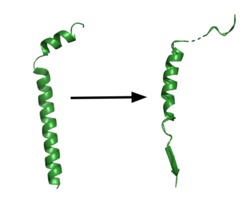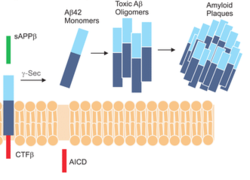User:R. Jeremy Johnson/Gamma Secretase
From Proteopedia
(Difference between revisions)
| Line 31: | Line 31: | ||
Mutations in GS are also connected with AD. Over 200 of GS mutations have been linked to causing AD. These mutations target "hot spots" on the enzyme and are aggregated at the interface between <scene name='83/832945/Ps1_subunit/1'>PS1</scene> and APP (Figure 1). The vast majority of these mutations are clustered in regions surrounding the C-terminal half of the <scene name='83/832945/Beta_sheet_complex/1'>APP TM helix and the β-strand</scene>. Mutations at these locations affect the integrity of APP recruitment and catalysis, implicating a role in the development of Aβ plaques that impair neural function.<ref name="Zhou" /> | Mutations in GS are also connected with AD. Over 200 of GS mutations have been linked to causing AD. These mutations target "hot spots" on the enzyme and are aggregated at the interface between <scene name='83/832945/Ps1_subunit/1'>PS1</scene> and APP (Figure 1). The vast majority of these mutations are clustered in regions surrounding the C-terminal half of the <scene name='83/832945/Beta_sheet_complex/1'>APP TM helix and the β-strand</scene>. Mutations at these locations affect the integrity of APP recruitment and catalysis, implicating a role in the development of Aβ plaques that impair neural function.<ref name="Zhou" /> | ||
| - | Inhibition of GS could be a potential AD treatment, but this would require targeting only APP cleavage over other GS substrates. APP cleavage leads to products such as Aβ42 and Aβ43,<ref name="Yang">PMID:28628788</ref> which are prone to aggregation and formation of Aβ plaques (Figure 2). Increased product peptide length contributes to aggregations, and many of the mutations within <scene name='83/832945/Ps1_subunit/1'>PS1</scene> result in elevated ratios of Aβ42 to the shorter Aβ40 (Figure 2).<ref name="Bai">PMID:26280335</ref> The differential binding of APP and Notch to GS provides a starting point for differentiation but will require further follow-up studies to confirm that the structural differences observed are biologically relevant. Currently, to combat this complex situation, differences in binding between different substrates are being utilized to create drugs that selectively inhibit APP binding with GS, and possibly create a more ideal target for AD treatment.<ref name="Zhou">PMID:30630874</ref> | + | Inhibition of GS could be a potential AD treatment, but this would require targeting only APP cleavage over other GS substrates. APP cleavage leads to products such as Aβ42 and Aβ43,<ref name="Yang">PMID:28628788</ref> which are prone to aggregation and formation of Aβ plaques (Figure 2). Increased product peptide length contributes to aggregations, and many of the mutations within <scene name='83/832945/Ps1_subunit/1'>PS1</scene> result in elevated ratios of Aβ42 to the shorter Aβ40 (Figure 2).<ref name="Bai">PMID:26280335</ref> The differential binding of APP and Notch to GS provides a starting point for differentiation but will require further follow-up studies to confirm that the structural differences observed are biologically relevant. Currently, to combat this complex situation, differences in binding between different substrates are being utilized to create drugs that selectively inhibit APP binding with GS, and possibly create a more ideal target for AD treatment.<ref name="Zhou">PMID:30630874</ref></StructureSection> |
| - | </StructureSection> | + | |
== References == | == References == | ||
<references/> | <references/> | ||
| - | |||
==Student Contributors== | ==Student Contributors== | ||
Daniel Mulawa | Daniel Mulawa | ||
Layla Wisser | Layla Wisser | ||
Revision as of 16:51, 5 May 2020
Gamma Secretase
| |||||||||||
References
- ↑ 1.0 1.1 1.2 Bolduc DM, Montagna DR, Seghers MC, Wolfe MS, Selkoe DJ. The amyloid-beta forming tripeptide cleavage mechanism of gamma-secretase. Elife. 2016 Aug 31;5. doi: 10.7554/eLife.17578. PMID:27580372 doi:http://dx.doi.org/10.7554/eLife.17578
- ↑ 2.0 2.1 2.2 2.3 2.4 2.5 2.6 2.7 Zhou R, Yang G, Guo X, Zhou Q, Lei J, Shi Y. Recognition of the amyloid precursor protein by human gamma-secretase. Science. 2019 Feb 15;363(6428). pii: science.aaw0930. doi:, 10.1126/science.aaw0930. Epub 2019 Jan 10. PMID:30630874 doi:http://dx.doi.org/10.1126/science.aaw0930
- ↑ 3.0 3.1 3.2 Yang G, Zhou R, Shi Y. Cryo-EM structures of human gamma-secretase. Curr Opin Struct Biol. 2017 Oct;46:55-64. doi: 10.1016/j.sbi.2017.05.013. Epub, 2017 Jul 17. PMID:28628788 doi:http://dx.doi.org/10.1016/j.sbi.2017.05.013
- ↑ 4.0 4.1 4.2 Bai XC, Yan C, Yang G, Lu P, Ma D, Sun L, Zhou R, Scheres SH, Shi Y. An atomic structure of human gamma-secretase. Nature. 2015 Aug 17. doi: 10.1038/nature14892. PMID:26280335 doi:http://dx.doi.org/10.1038/nature14892
- ↑ Bachurin SO, Bovina EV, Ustyugov AA. Drugs in Clinical Trials for Alzheimer's Disease: The Major Trends. Med Res Rev. 2017 Sep;37(5):1186-1225. doi: 10.1002/med.21434. Epub 2017 Jan 13. PMID:28084618 doi:http://dx.doi.org/10.1002/med.21434
- ↑ Kumar D, Ganeshpurkar A, Kumar D, Modi G, Gupta SK, Singh SK. Secretase inhibitors for the treatment of Alzheimer's disease: Long road ahead. Eur J Med Chem. 2018 Mar 25;148:436-452. doi: 10.1016/j.ejmech.2018.02.035. Epub , 2018 Feb 15. PMID:29477076 doi:http://dx.doi.org/10.1016/j.ejmech.2018.02.035
Student Contributors
Daniel Mulawa Layla Wisser


